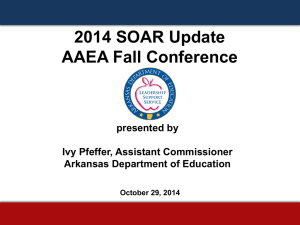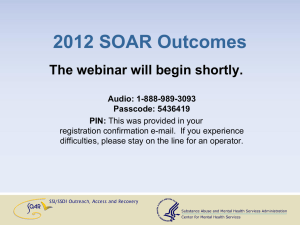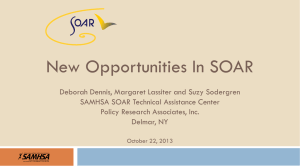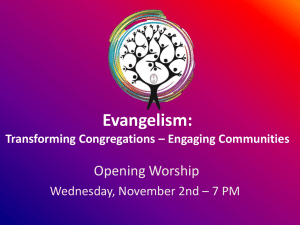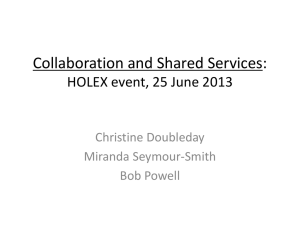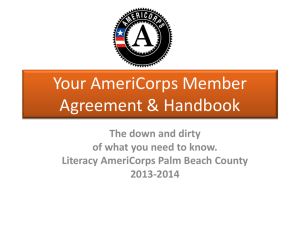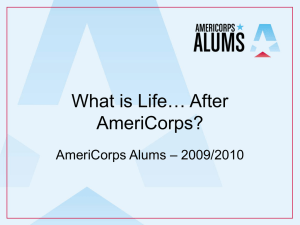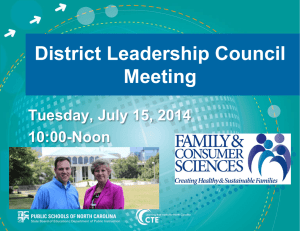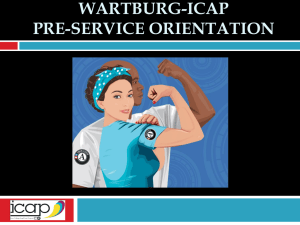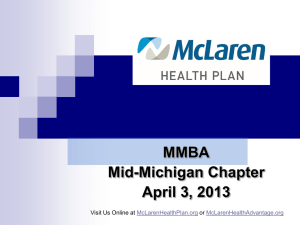May 20, 2014 - SOAR Works! - Policy Research Associates
advertisement
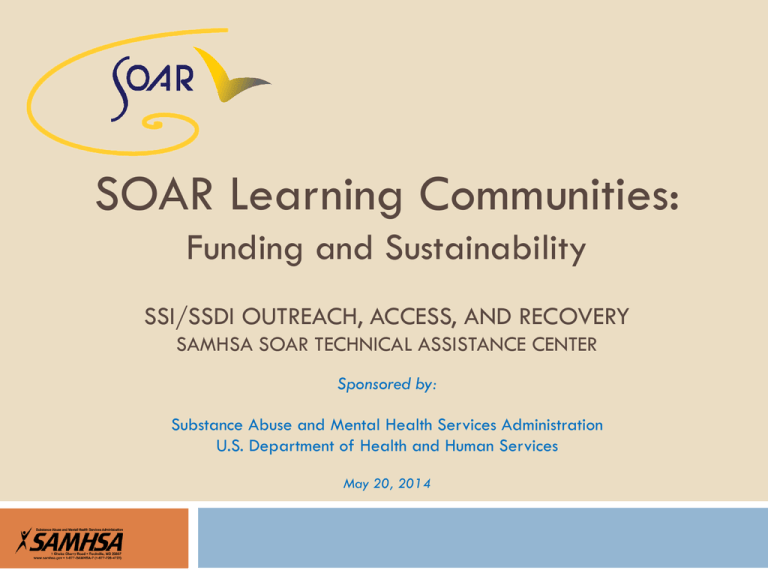
SOAR Learning Communities: Funding and Sustainability SSI/SSDI OUTREACH, ACCESS, AND RECOVERY SAMHSA SOAR TECHNICAL ASSISTANCE CENTER Sponsored by: Substance Abuse and Mental Health Services Administration U.S. Department of Health and Human Services May 20, 2014 Welcome Jen Elder, M.Sc. Senior Project Associate SAMHSA SOAR Technical Assistance Center Policy Research Associates, Inc. Logistics Recording Downloading materials Poll questions Chat questions Live Q&A Learning Community Call Agenda Creating a Funding Framework Federal Funding Streams State Funding Opportunities Private Foundations Local Partnerships Questions & Answers POLL QUESTION #1 Funding SOAR Programs There is no dedicated source of federal funding for SOAR programs Yet, all 50 states participate! Reallocating existing resources Securing funding through federal and state grants and foundation funding Establishing collaborations with hospitals and criminal justice settings Create a Funding Framework Know your “ask” Explore potential resources Create a funding action plan Who, what, when, how Record and revisit responses Market your program Show value for money Develop an elevator pitch Elevator Pitch 30-60 second introduction of your program to funders, new partner agencies, referral sources, etc. Communicates: Who you are What you do How you do it The benefits it brings Call to action Creating an Elevator Speech Worksheet Practice! Elevator Pitch Example I’m John Smith, SOAR Coordinator at the Downtown Shelter, which provides homeless services to 1500 individuals a year. We help about 50 people per year obtain Social Security Disability benefits. What makes our program different is that we have a successful Social Security advocacy program called SOAR that helps many disabled individuals quickly access cash benefits and health insurance. We’ve helped 175 individuals obtain Social Security benefits since we began our SOAR program in 2011. Applicants in our program access stable housing and healthcare in an average of 65 days from date of application. We change lives! We’re looking for partner community mental health agencies to expand SOAR efforts in the city. Can we introduce your staff to the SOAR model at your weekly staff meeting? QUESTION: What funding resources are you using, or have you explored for SOAR in your community? **Use this tool at the bottom of your screen to write answers on the whiteboard Please don’t use the delete button! Federal Funding: SAMHSA Projects for Assistance in Transition from Homelessness (PATH) Similar components: Outreach, engagement, assessment, documentation, recovery PATH funds support dedicated SOAR benefits specialists, SOAR training, and statewide leadership and coordination in many states Encourage your State PATH Contact to include SOAR activity in PATH contracts Federal Funding: SAMHSA Community Mental Health Services Block Grant (MHBG) Cooperative Agreements to Benefit Homeless Individuals (CABHI) Olmstead Adult Treatment Drug Courts Federal Funding: HUD Community Development Block Grant (CDBG) A flexible program that provides communities with resources to address unique community development needs Distributes annual grants on a formula basis to local governments and states SOAR programs have used these funds to support dedicated benefits specialists Federal Funding: AmeriCorps AmeriCorps State Provide direct outreach, engagement, and assistance with SSI/SSDI applications A cash or in-kind match is required for program costs Apply for a grant through your governorappointed State Service Commission www.nationalservice.gov Federal Funding: AmeriCorps VISTA AmeriCorps VISTA Can identify potential SOAR collaborations, organize local SOAR planning meetings, fundraise for dedicated SOAR staff, collect data, and coordinate future trainings Apply through your state Corporation for National and Community Service office No required funding match from sponsors, but there is a cost-share option SOAR TA Center issue brief on AmeriCorps Medicaid and State Health Programs Medicaid is a state-operated program, federal and state share the cost State creates a plan for what services are billable Case management services necessary for SOAR applications may be billable or allowable services Tennessee: Behavioral Health Safety Net providers can bill for SOAR application assistance Georgia: 6 regional positions statewide for Medicaid Eligibility Specialists State or County General Assistance General assistance (GA) funds offer time-limited cash benefits to adults without dependents who have limited or no income These benefits are not available in every state Through an Inter-Agency Reimbursement (IAR) agreement, SSA can reimburse state or local public assistance funds when individuals begin receiving SSI/SSDI Successful Models: Minnesota Department of Human Services (DHS) administers the General Assistance (GA) program Up to 35% of GA recovery under interim assistance provisions can be retained by DHS to provide “advocacy, support and claim processing services” DHS contracts for SOAR application assistance State pays $750 for applications submitted with Medical Summary Report and Quality Review checklist $1750 additional for successful applications at initial and reconsideration levels State or County Temporary Assistance for Needy Families (TANF) TANF is a block grant from the Department of Health and Human Services Provides time-limited assistance to families with dependent children to help them become selfsufficient through employment For parents who can not meet the TANF work requirements, assessment of eligibility for SSI/SSDI may better meet their needs and save state funds for others in need Successful Models: Philadelphia, PA Homeless Advocacy Project (HAP) contracted with the State Department of Public Welfare (DPW) to use SOAR with TANF recipients DPW The State Department of Behavioral Health (DBH) identified individuals with severe mental illness DBH provided contact information for TANF recipients provided HAP with medical evidence HAP’s approval rate on initial applications is 99% in an average of 34 days State/Local Plans to End Homelessness Most plans to end homelessness incorporate increasing access mainstream benefits Can fund SOAR leadership, coordination, and dedicated benefits specialists. Find your local plan and promote how SOAR helps meet this goal Nashville, TN: 10-year plan funds 3 positions in community mental health center Since May 2006, 97% of 522 applications approved in an average of 40 days Foundation & Other Private Funding United Way: funds coordination of SOAR in Trenton, New Jersey; and staffing of SOAR programs in other localities Pharmaceutical and insurance companies: GlaxoSmithKline, Blue Cross Blue Shield, and Kaiser Permanente fund SOAR programs in North Carolina and Oregon www.foundationcenter.org Successful Models: North Carolina Combined funding stream from: foundations, hospitals, local, state, and federal Focus on helping localities develop and sustain benefits specialist positions 22 FTEs and 3 PTEs in 14 communities 813 applications, 80% approval rate in 85 days Hospital Collaborations Hospitals can recoup payments for previously uncompensated care when individuals approved for SSI obtain Medicaid SOAR providers may receive funding from hospitals for dedicated SOAR benefits specialists to help individuals access SSI/SSDI and health insurance In 2013, States reported an average $7,417 reimbursed from Medicaid per SOAR approval In 2012, Mercy Hospital in Michigan reimbursed $852,557 after using SOAR to assist with 45 applications SOAR TA Center issue brief on hospital collaborations Criminal Justice System Collaborations Diversion courts, in-reach initiatives, re-entry planning, and SOAR trained corrections staff Reduces recidivism and prevents incarceration, which in turn saves money for states and communities In 2009, the Miami-Dade Jail Diversion Program estimated cost-savings to the state of $7 million Results leveraged on-going funding for SOAR SOAR TA Center issue brief on criminal justice collaborations Other Partnerships Programs serving targeted groups Veterans Youth leaving foster care Local colleges and universities Social work field placements or internships Students get experience working with clients and help grow an agency’s SOAR program Peer Support organizations SOAR TA Center issue brief on utilizing peer support workers with SOAR Sustaining & Growing SOAR Be creative Use your outcomes Share success stories with the press Give presentations to potential funders Create linkage with influential leaders—both private and public Keep persisting! Funding and Sustainability Tools Funding and Sustainability Worksheet Sample SOAR Proposal with Budget Sample SOAR Proposal for Jail Collaborations Funding and Sustainability Best Practices Issue Briefs from the SOAR TA Center Visit the SOAR Website Often! http://soarworks.prainc.com QUESTIONS & ANSWERS Connect With Us SAMHSA SOAR Technical Assistance Center http://soarworks.prainc.com soar@prainc.com www.facebook.com/soarworks @SOARWorks
